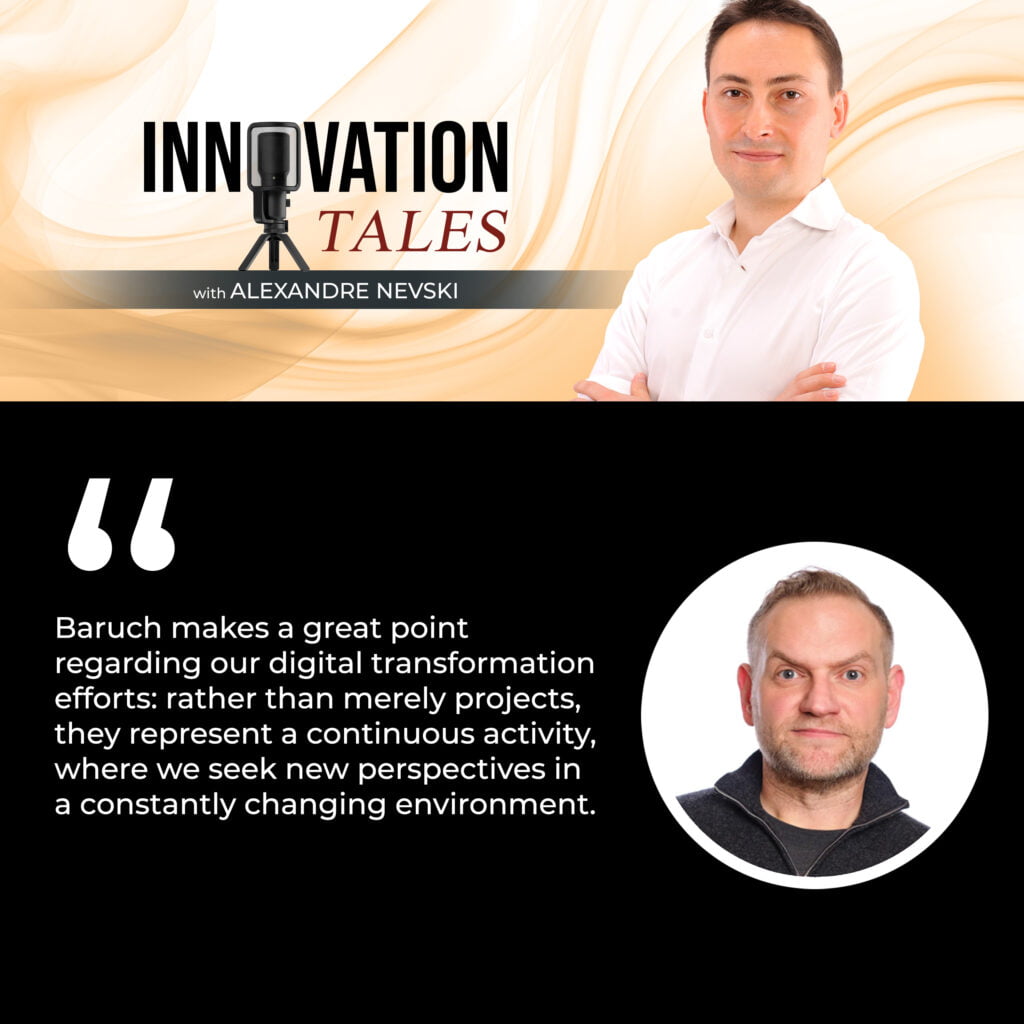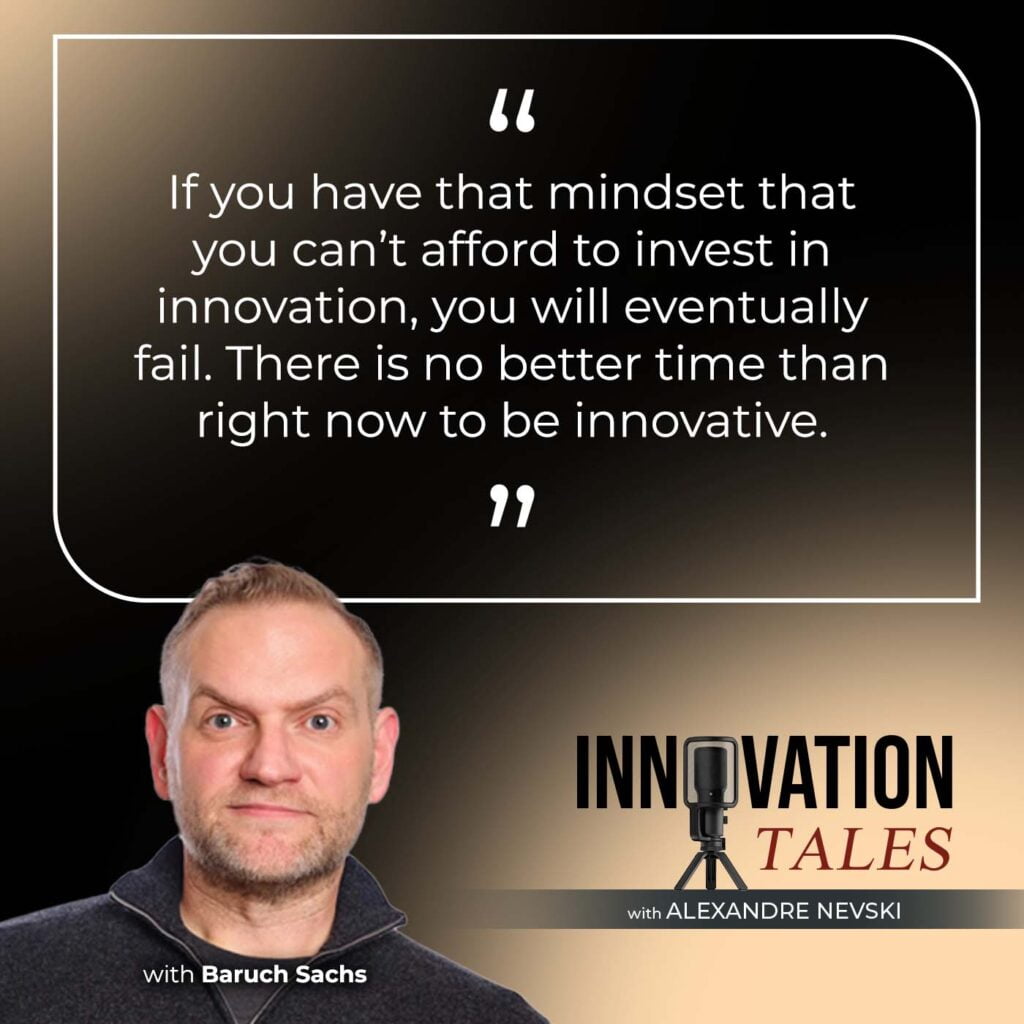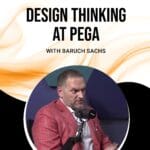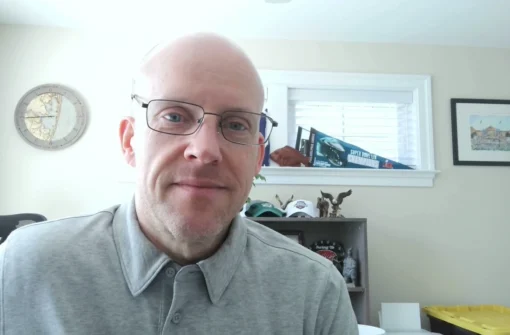
Design Thinking At Pega With Baruch Sachs
Have you ever had a feeling that a new technology solution was not addressing the actual challenges faced by your organization? Why do project teams regularly commit to a solution before getting a chance to validate its relevance? Alexandre Nevski sits down with Baruch Sachs, Vice President of Global Client Innovation at Pegasystems, to explore the benefits of design thinking. Looking back to his first-hand experiences as a designer, he shares how he led the company to partner with its clients to help them understand their challenges before committing to a particular technology solution.
Pega® is a trademark of Pegasystems Inc. Please visit https://www.pega.com to learn more.
Transcript
Have you ever had a feeling that a new technology solution wasn’t addressing the actual challenges faced by your organization? Why do project teams regularly commit to a solution before getting a chance to validate its relevance? In this episode, we explore the benefits of design thinking with Baruch Sachs, Vice President of Global Client Innovation at Pegasystems. He shares his story as a designer who led the company to partner with its clients to help them truly understand their challenges before committing to a technology solution.
Baruch leads a team of experts in creating better enterprise technology solutions using business outcomes, design thinking, and rapid prototyping. With over 17 years of experience at Pega and multiple patents in user interface design, Baruch is a visionary in the field of digital transformation. Without further ado, here’s my conversation with Baruch Sachs.

Baruch, welcome.
Thanks, Alex. Good to be here.
It’s an immense pleasure to have you on the show. I feel since you introduced design thinking to Pega, my client engagements have profoundly changed. I’m pretty sure that there are a lot of practitioners around the world who would probably say the same. We’ll define what Pega Catalyst is in a later segment, but let’s start by giving a bit of context to our audience. When it was introduced, I think it was 2019, what was the challenge that it was addressing?
The challenge was the fact that in most software companies, we sell software based on features and functions. We go and think we know a problem and we come up with a solution. We want to just jump into the solution space. That’s good, but it’s not great and it’s not great because what you’re trying to do is solve a solution without truly understanding if the problem that you’re solving is the right problem to solve.
In general, in technology, design thinking has become a thing, most of the time we have to dig deep into our past to brush off solutions and apply them to new problems. Design thinking is one of those things. Design thinking is 50 to 60 years old and suddenly it became a hot new thing over the past 6 or 7 years. It’s not anything that is crazy. It is simply saying, “Do you know what? I don’t know if the problem I’m trying to solve is the right problem.”
I think I know the problem, but it would be great to not just tell a client or tell anyone what the problem is. Let’s make sure that we’re figuring out together what the problem is that we’re trying to solve and do it in a way that sparks creativity because it is hard to focus outside of your day-to-day. Your day-to-day dictates what it is that you do.
What we found is when we’re talking to prospective clients and trying to help them see the value that Pega would bring, they were just framing their problems and framing the solutions they wanted to solve the problems that they had today. It was hard for them to say, “If I didn’t have this problem, how would I solve a future problem?” “How would I solve a different problem?”
Maybe I have a call center, for instance. I think that I need better customer service software and customer relationship management software. I need to improve the quality of my calls. That might not be true. You might want people to stop calling you and you want to put your energies into developing other channels, like self-service channels or web channels.
I don’t want people calling me for a lost password. I want to focus my call center agents on solving complex problems but when all you’re getting are lost password questions, you’ll think, “How do I solve that?” I need better software to do that. I need to rethink my problem. That’s where design thinking came in. That’s what we were trying to use to solve.
That’s also the experience that when I mentioned that my client engagements have changed. As a result of this approach being the Pega standard, it became easier to validate that there is an actual problem to solve or that we are solving the right problem. Before that, I guess we were very much in the field, copying and pasting solutions from one engagement to the next.
Whilst this has a tremendous advantage in terms of cost reuse and stuff like that, definitely having designers come in and challenge you was I think very useful and still useful to this day. It’s been a few five years now, I guess. From your perspective, what were the trends in those last five years that have profoundly changed the work of designers, and what ended up being nearly buzzwords?
Yes, design thinking, when you say that to people, what has happened is because it became prevalent quickly and firms IDO and Stanford Design School and all these folks glommed onto it, what happened is that since everybody was doing it, then it became somewhat of a sameness. One could argue that the standard approach to addressing business requirements and business architecture and then delivering those is a good thing.
What happened was that since everyone was doing it, it became a little bit buzzy just to begin with. Then certainly, if you had a client who experienced design thinking exercises from us or another vendor. They said, “Before we could do anything, we should all get together in a room and put sticky notes up on a wall and figure this out. People will say, “We did that.”
It was good when we did it in that room but then we left and we just fell into our same old habits. What you’re proposing, Pega or anyone, is not that unique to us. What we had to do was then say, “How are we going to do design thinking here?” As you may imagine, here at Pega, we think of ourselves as rather special with our software and what we do.
We were going to adopt a very standard approach of design thinking to something very special. We were negating the benefits of what the technology could do. Where it has changed is, I think when we started, we were doing more pure play, design thinking, because it was easy entry, very low tech. You got people to align things.
As they got a little more sophisticated, maybe that was the second session we did or the third session we did. We started to introduce, “Let’s lean a little bit more on the technology because it’s such an accelerator.” It is not the end-all-be-all, but maybe we can incorporate this a little bit into our design thinking approach to speed it up.
That’s the other thing we saw as change. I would say when we started, we were doing a lot of in-person design thinking workshops. The pandemic happened. Overnight, we had to switch to a hybrid approach. How do we do that? How do we mimic that? We were successful at it, and there are tools out there that helped us do those collaborations, but we missed out.
There was a human element of missing out. I have to say a lot of times, the work we do, there are huge benefits to it, but sometimes the biggest benefit is more of getting people in a room that think they know each other. Work together every day, think they know each other’s problems, and we facilitate. Like the facilitation of two groups of people, which is normally business and IT, other teams come in, but mostly it’s business and IT.
They think they know what each other does. They could be working together for 25 years. They could have barbecues every Sunday. They know each other’s kids and everything that. They’re like, that’s so-and-so down the hall that does a job but when you bring them together and it’s someone outside in who facilitated, there’s always an aha moment. “I didn’t know you did that.” “I thought you did this.” How did you not know that? You work with this person.
That’s what design thinking brings and those are some of those intangible benefits that go way beyond sticky notes and all of that stuff. You lost that during the pandemic. I think that once we’ve gained that back now, we could be in person and talk through some of that stuff. You’re just seeing this massive shift towards being able to do things a lot faster because the other thing we are seeing is there’s exhaustion. It’s not just Pega, but it’s every vendor that wants to go into a client. They’re like, “Yes, spend some time with us, spend three days, spend four days.”
If I do that with 16 vendors, it’s a lot of time that I’m not doing my job. Clients are starting to get that exhaustion. It’s like, “No, don’t spend a week with us, spend a day.” How do I condense that beautiful process that we did for a week? How do I condense that into a day? That’s a challenge that we’ve been able to overcome pretty successfully, but we’re still learning.
Echoes Of Innovation
Baruch, in this segment, we use storytelling to bring our audience authentic insights. However, I always advise my guests to use discretion with names and specifics. To honor confidentiality agreements, and to respect people’s privacy. With that in mind, it would be great to hear a story that would illustrate the trends that you discussed regarding applying design thinking and Pega Catalyst in the last few years that would illustrate how the work of a designer has been transformed by those trends.
Sure. Even though I had this organization of Pega client innovation, my training is in design. I started on the consulting side, and the services side, as a design person. I could tell these stories about myself because I have no privacy but in general, we have to gather in certain areas. Maybe a lack of maturity. When you work for a technology company as a designer, there is a lot of misunderstanding about what it is that designers do.
You realize that it’s not the design activities that you’re doing but maybe a lot of your role within an organization is to build a design mindset, a design culture that’s going to foster the ability to make it just as important. You would never say on a large technology implementation, you wouldn’t have some level of system architecture. You could very easily overlook the fact that you might need a UI person.
That’s what we had some time ago.
By coming in, they say, “We have a design person right now.” I remember I was about a week into this job that I had here at Pega when I first started. Somebody on a project said, “Thank god we have you. We need your help.” Of course, I was very excited by that. I said, “Yes, how can I help? This is great.” They said, “We need you to come out to predict your client. We need you to look at what we’ve built and help us understand how we can build it better.”
I said, “This is exactly what I do.” Good. I asked a few qualifying questions. I said, “Who’s the client?” “What industry are they in?” “What are you building?” Standard stuff and then I said, “When are you scheduled?” You said it’s already built and then a little warning signs on the back of my head. I said, “When are you going to go live?” They said, “Next week.” I said, “Wait a minute. You’ve already been through all of the stuff.” They said, “Yes.”
I’m like, “How would I make any fundamental core changes?” “No, that’s fine. We just need you to pick a pretty color.” The client doesn’t like the color. Pick colors. I said, “This is what you think it is that I do.” Now you fast forward several years and you fast forward where technology companies have embraced artistry. You could look at Apple as being huge and say that technology does not have to be all about the technology.
Technology should be about a level of creativity. It should be a level of elegance. Let’s mimic what we do in our lives because in our lives we crave simplicity. We crave that in our relationships. We crave that with our work. We crave elegance. We pretty things. Humans are just generally comfortable with that and it makes you feel good.
Technology does not have to be all about technology but more about a level of creativity.
I always identify with it. I think if you have business applications or mainframe or data-centric, old stuff. You think of your job as this bulky work that is not creative. If we can give them an application that is a bit like an Apple product I think they feel just differently about the work.
They do and if I look at the physical world it would be akin to if you said, “I’m going to buy this piece of land.” Then you go to a builder and say, “Just build this house.” You probably wouldn’t do it that way. You would get an architect. You would get somebody to understand dimensions and how is this built and what’s the right use of space, et cetera.
If I’m walking down in a neighborhood and I walk down a street and the sun is beaming and that street has no trees, it’s just concrete. It’s hot. It doesn’t feel safe. It feels less good to me as a human being but if I walk down a very tree-lined, shady street. It’s cooler, there are some physical things, but it also just feels nicer. It just feels like a nicer experience.
It’s those intangibles in a technology world, an engineering-focused world, they’re very hard because people are not necessarily wired that way. When you bring up physical real-life examples, you get a couple of reactions. Most of the time you get this, “Yes, I never thought of it that way.” or “I never even noticed.” You realize that people experience the world in different ways.
As a designer, it can be challenging, but super interesting. If I look at the story of when I first started as a designer to the fact that you fast forward and you have all of these improvements in the technology world around the appreciation for design. Some of that stuff is very surface, and you will always find people saying, “They’re just dabbling in it, they don’t understand what we do.”
There is a stereotypical, often maligned designer. They’re perpetually frustrated because no one appreciates their artistry. I took a different approach. I could have easily gone that way. Certainly, when I started in design, I just had this weird view that I would do amazing things and solve amazing problems. What I realized though is the reason why I got into design was born out of laziness.
I started as a technical writer. If you want to go way back. I wanted to be a philosopher. I have a degree in philosophy and philosophy is where it’s at, it’s cool. Until I realized I would make no money. The days of walking around Socrates, I don’t think can happen for me. I said, that I’m a pretty decent writer. Maybe I should get into this world of technical writing because it seems that’s a job.
My first job out of college was as a Technical Writer. I sat down and I started documenting. What I realized very quickly was I was writing a lot. I was documenting a lot to make up for the bad design of the software I was writing about. I said, “If we just designed the software differently, I could write less. I realized that my greatest contribution was not in writing, it was in software design.
Let’s think about how I would use it, and if I don’t have to write so much about it, it means that the software’s easy to use. Now Apple took that to great lengths where you don’t get any instruction books, right? We used to always write these big books that nobody would read unless there was a problem. If you design something, there’ll never be a problem, or it’ll be intuitive that I don’t need to read anything about it.
I’ve successfully done something good with design. You go through this natural progression where you start realizing that design for design’s sake is not going to work but design aligned with business objectives and business outcomes is where you see things. If you want to be a purist in design, which I was when I started, and I think most designers are.
You realize that to align it and be successful, you need to think about who’s using it, and why are they using it, and not create beautiful screens for the sake of beautiful screens. Sometimes a very ugly screen will be very utilitarian and it’ll be great. It’ll work just well. It doesn’t require you to apply these elegant design principles.
Focus on where you’re going to get the most business justification for it. Now, I think about where I am as a design person, have expanded the repertoire of what we do. Design is very much a core focus of the Pega Catalyst program or innovation, but it’s not the sole focus. It’s a design-led approach that focuses on business objectives, business architecture, and outcomes.
It’s much more strategic, I think.
Yes, it’s much more strategic. What I realized is that it takes you several years to get to that point where you start feeling maybe you have some lessons to impart to others. I could have easily not ever thought about the design programs that I went through in college and grad school. I reached out recently, the past number of years to say, “I’d be happy to guest lecture at these graduate-level classes.”
Going in and seeing people that some of them have been in the workplace for a year, and some of them have been there for 10 years. You start talking about this and it did resonate. You see their arc, you see their progression as a design person and you start having these conversations that I don’t think are happening enough in the design community about the changes of design and how design is going to influence the development of technologies and the development of products in the years to come.
It just has to take a more practical approach. The biggest storyline for me is that you go from surety to practicality. If you told me when I was in my 20s, “Baruch, don’t worry, you are going to get to that practical level.” I would say, “You don’t know what you’re talking about. I’m going to be able to do everything I want to do without change.” It’s everyone else that has to change.
As you start having experiences, you realize that you can be angry about it all your life, but if you want to be practical about it, you figure out how to weave through it and you figure out how to mature it so that it has the bigger impact. That arc from purity to practicality is one that I don’t think is talked about a lot, but I often think about it as my design story as I went through my career.
Blueprints Of Innovation
Before we move on to the next segment, if you found this tale of innovation insightful, please like and subscribe to help us grow our audience. Now we’re into the descriptive bit. Do you want to talk about Catalyst? Do you want to talk about something else?
I don’t think we have to talk about Catalyst as a program in general. I could talk about it without even saying the word Catalyst and what is it that we do.
You mentioned the word Catalyst. One of the ways this segment could be used is just to give a two or three-minute description because whilst the guests are practitioners, the target audience is mostly business and industry leaders. Give them that elevator-page short version. Unless there was something else, and maybe that’s not mutually exclusive.
No, I think that’s fine. I could quickly talk about why we did it, and what it means as a technology provider.
Sounds good. Baruch, in this second segment, we’ll look at the tools and methods. You’ve mentioned Pega Catalyst, and I think I mentioned it as well. I think it would be good to give our audience a brief overview of what this approach entails.
Sure, the Pega Catalyst program started about five years ago within Pega. The reason why it was started was there was this better understanding of a need to much more deeply engage our clients and potential clients in a couple of different areas. If you wanted to sell somebody something and you were successful at it, there was often a gap between when a deal closes and then when you start developing that.
If you successfully sold something to somebody, there is often a gap between when a deal closes and when you actually start developing the product.
People might have left the organization, there might be shifting priorities, and oftentimes there were. That handoff that is always pervasive between sales and delivery might not have been done effectively. Then you start building something for a client, it doesn’t go well or it stalls out. You realize what you’re building is solving a problem that’s no longer a problem or the problem is morphed or the requirements are crazy, or you’re just building the wrong thing, to begin with.
I started thinking about the fact that if we could get engaged earlier on, we could do much more aligned with our business and IT organizations within this client to ensure that the problem we’re solving is the right problem, it’s critical to the business, and you get that alignment. Your success would be a lot better. Also, it tried to solve this articulation of what PEGA does.
By going at it less from a technology perspective and more from a business perspective, you’re reaching that business audience that honestly doesn’t care about Pega or what technology you’re using. They have a problem, they would like it to go away. You start talking in a different language. You start talking about what business problems are keeping you up at night.
Sometimes our clients will come to us and say, “We know Pega is the right solution. Just don’t know where to start. We’re paralyzed.” You have to start understanding that in these large organizations, people get scared. They get scared that they’re going to fail. They get scared that they are going to not have a job because they fail, those types of things.
We started the Pega Catalyst program to de-risk the investment. We started to invest in our clients to de-risk the investment they made in us. That was a very key shift. We call it Pega Catalyst, but what it means is we are going to apply a design-led approach to better understand your business, better understand the problems you’re trying to solve, align stakeholders, and figure out what is the most important problem that we’re going to go solve.
We’re going to very quickly showcase how that would look in action, meaning a prototype of some sort and we are going to help you sell it internally to your audience, to your stakeholders, and your leadership. When we first started this program, we did a lot of executive presentations. We now almost exclusively have our stakeholders and our clients who do it themselves.
They can help them, but it is much better for them if they own it.
Absolutely. I would rather have a client be able to pitch that they need Pega without us ever uttering a word. I don’t even want to be in the meeting. I would love it if they could confidently articulate the value. What we found too is you find a stakeholder in an organization, who wants to use you but are they saying the right things?
You don’t necessarily know or have insight into how they’re using Pega to sell what it is that they want to do. Having a little bit more control over that is a great advantage. The key is we don’t lead with the technology bent. We lead with the business problem bent, which is huge. We start speaking that language versus a technical language. You’re just going to reach a broader audience with a potential client.
I remember coming back from one of the Pega Worlds probably 2019 and being inspired by your presentation. I think it was with Digital Fast Forward that you were doing. I said, “What is this? This is super interesting.” I picked up a book and read it. Two weeks later, we were doing a design sprint for one of our clients by the book because we were new to this. Despite probably fumbling a little bit because completely new to this.
I’m not from a design background, although through interactions with you and some of your team members, I think I tried to learn about it a little bit more, but back to the client we first applied some design thinking. Their feedback was, “Wow, we should always be working like this.” Of course, you can’t because it’s very high-intensity and energetic. You can’t sustain it. To me it represents the advantage of thinking this, thinking through what is the problem space before thinking about the solution space because the clients come out of this exercise much more energized.

They do. I think the energy that you’re talking about is a key one because as we’ve been talking about throughout all of these segments, how have things changed? How have things matured over time? What are the learnings you’re taking? We used to just be okay and happy that we got that energy and we stopped, we moved on to the next thing. That energy, what we found is super fleeting.
I don’t know if you ever have gone and seen a motivational speaker or anything like that. You’re sitting in an audience, dark auditorium, the person’s speaking, and you’re like, “I feel like I can make a change in my life, in my business, in my relationship, or whatever it is.” What this person is saying resonates and you get energized.
You leave that auditorium, you go back to your regular life, and you’re like, “I don’t know how to turn that into reality.” “I don’t know actually how to turn that into change.” When we started the Paga Catalyst program, we felt that it was enough to just energize our clients and that they would be able to go and do great things.
What we realized is we do need to stay longer and engage longer. One of the things that has kept me at Pega for a long time is the way we treat our clients. We don’t treat it very transactionally. We treat it throughout a life cycle. When I talk to friends and colleagues and other software companies, they’re asking, “Are you in pre-sales?” “Are you in post-sales?” I like to say that we’re in continuous sale.
It’s a continuous approach. I don’t want to just sell you one thing and forget about you. I’d like to be able to sell you something and have you deliver it. Then a year from now, love it much. You want more and more and more. I can’t do that if I don’t invest the time in you. You know what I mean? A lot of software vendors talk about, “We don’t want to be just a vendor. We want to be a trusted partner.”
Those are the common terms for it and I say, “If you want to be the trusted partner. After you’ve sold this deal and after you turn it over to somebody to deliver it, how close are you to the delivery?” That’s the delivery partner that does it. At Pega, we do things a lot differently where we’re able to say, “No, we are with you and if there’s a problem, you can call us.”
In the Pega Catalyst program, we used to just stop after an engagement and we never capitalized on that excitement and it was a mistake. What we realized is that excitement needs to be nurtured and that excitement and energy need to be properly channeled and facilitated into making something real happen. A year from now, if I go talk to, maybe it’s Pegaworld to Pegaworld.
I talk to a client at Pegaworld, we engage with them for a few months. I want them to come back. I’m proud to say that if I track our record there of several Pegaworlds, I might have a meeting and then we work with them. By the next Pegaworld, they’re up on the main stage speaking about their experiences, which I think is just a tremendous testament to that level of nurturing relationships and not abandoning your client. Making sure that their energy and excitement are channeled into the right things.
Innovator’s Playbook
Awesome. In this third and last segment, we aim to provide practical advice for our audience. What do you think business and digital leaders should consider when they’re thinking about design and innovation nowadays?
What I’ve seen that has led me to this is the fact that we are confused about what innovation is. Transformation is this slow burn. It can start slow, it can grow and grow. If you don’t contain it, it becomes out of control. Most of our clients have transformed for years and years and have not succeeded. I think it’s a mentality.
Transformation is a slow burn that can grow nonstop. If you do not contain it, transformation will go out of control.
We are looking at the problem of transformation in fundamentally the wrong way. Instead of something that has a start and stop, it is something that is continually built into your DNA because. A year ago, Gen AI wasn’t a thing. Any business leader in 2019 who said, “I have a five-year plan.” 2020 came and everybody’s plan went away.
I think being able to say that transformation is just part of our DNA, it’s part of our culture, and we will adapt is a core tenet of being able to continue to remain relevant for years to come. Innovation is also thought of differently and perhaps in the wrong way where a lot of times people think innovation is something new.
And innovation is 99% of the time, nothing new. It is taking what exists already and thinking about it in a new way. That critical thinking, that process, that ability to look at things and say, “I’m going to take a step back, shake my head, look back at it again, and say, My God, that’s how you should do it.” That is the innovative spark. Transformation is the slow-burning ember of a thing.
Innovation is that spark of creativity that happens in a nanosecond because suddenly I look at something in a different way and I can never unsee it. It’s those 3D pictures, it looks nothing, and then all of a sudden you see the image and you’re like, “My God, I can never see it.” I remember a famous story. I never thought growing up when I saw the Federal Express trucks, I never realized there was an arrow in the middle of that logo until somebody told me and I saw it. Now, I can never not see an arrow.
It’s one of those things. That’s that spark of innovation that can be replicated. The practical approach is to stop trying hard to put a stop to an end date to the transformation. Know that things will change, know that innovation will happen multiple times within a transformative process. Embrace the fact that you don’t always know what is happening.
Have an overarching goal, a North Star, whatever you want to call it, but just know that it doesn’t have a stop and know that it will always be changing. I think where we’ve seen the greatest success is with clients who have changed their mindset. People say, “I have a three-year transformation project.” or “One-year transformation project.” Now people are saying, “I have a transformation goal.”
A transformation approach and I don’t know when it might stop. I don’t know if it has, it’s open-ended. I think any large organization, medium organization, or even a small organization needs to think about it all within the relative context of the fact that they should be continually doing a level of transformation with several innovations that happen throughout that process versus looking at a big bang approach or a big bang innovation, that becomes critical.
From a design perspective, being able to tie design towards business objectives, the design activities are changing. AI will change a lot of that stuff. We’re already using it to produce presentations, videos, and video scripting. You can use it to produce code. You could produce UI screens. It used to be everyone was in a design mode where it was about creating these perfect images, pixel perfect, and all of this stuff.
That is going away. That is becoming commoditized and AI is playing a part and will continue to play a huge part. My advice is don’t fear that. Accept it. A lot of times in the design world, you do things out of necessity, not because you love it. The design concepts that you’re coming up with and the creative side are still going to be there. AI is not a super fast tool.
I don’t want to spend a thousand hours in a video editing tool or an image editing tool or creating the perfect screens to then hand to a developer to develop. I want to come up with the ideas in the first place. For the people who like doing that, I guess my practical advice is hopefully you’ll find something else to like because those are the pieces, those tactical, very rote pieces that AI will supplant but it will free you up.
I’m happy to talk about the specifics, unlike those articles I mentioned in the past that don’t. That will free you up to come up with understanding your business better. You cannot design for a business without understanding the business. A lot of times in the design world, we talk about the fact that, “How am I supposed to design for a user that I’ve never met.” “That I’ve never seen.” “That I don’t know about?”
You cannot design for a business without understanding the business.
Take that same approach and apply it to the business that you’re doing. If you are not designing with your business objectives in mind, with a business goal, not understanding the organizational goals, and not taking the time to understand all that stuff, your design will be put to the side for the achievement of those business goals.
If you want to place at the table, understand where the work that you’re doing fits into the larger organizational goals. Again, design pieces that are very fundamental to the design world or not. We need to rethink that. It is the stuff that AI can do. Let it do it. Free you up to think about your design strategy in the art of the possible.
As we are about to conclude, are there any final thoughts you’d to leave our readers with?
I think in general, innovation will remain a key part of what software companies do, and what any company wants to do. Investing in innovation is going to become critical. Lots of times when the economy is bad or there are constraints or things like that, people say, “We just can’t afford to invest in innovation. If you have that mindset that you can’t afford to invest in innovation, you will eventually fail. There’s no better time than right now to be innovative.

There’s no better time that I can remember in my entire career when innovation is as important as it is right now. You do hear a lot of the word, “Innovation.” If you go back a little bit to my key point, just remember and keep in mind that innovation is not about newness. It is about looking at things, new. It’s a total subtlety, but it is an important one. Where if you look at something in a new way, that is what brings you forward. Not trying to create something new all the time.
A great point to finish on. Baruch, it’s been a pleasure.
Thank you.
That’s it for this episode of Innovation Tales. I hope you enjoyed Baruch’s account of the history of design thinking at Pega. I think he makes a great point regarding our digital transformation efforts. Rather than merely projects, they represent a continuous activity where we seek new perspectives in a constantly changing environment.
If you’re following us on YouTube, don’t forget to like and subscribe or you can rate and review the show in your favorite podcasting app. We look forward to your feedback. In the meantime, we have more topics and guests lined up, stay tuned for more Tales of Innovation that inspire, challenge, and transform. Until next time, peace.
Important Links:
- Baruch Sachs – LinkedIn
- Baruch Sachs – X
- Pega – Website
About Baruch Sachs

Baruch Sachs is the Vice President of Global Client Innovation at Pegasystems, where he leads a team of experts in creating better enterprise technology solutions using business outcomes, design thinking, and rapid prototyping. With over 17 years of experience at Pegasystems and multiple patents in user interface design, Baruch is a visionary in the field of digital transformation, helping clients navigate their journey and achieve their business goals.






